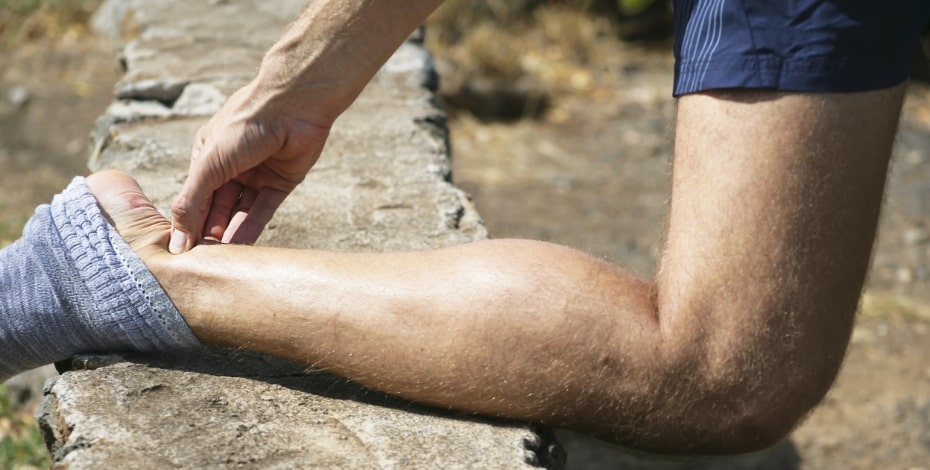
Recent thinking on Achilles tendinopathy

Peter Malliaras discusses his Invited Topical Review on physiotherapy management of Achilles tendinopathy in the latest issue of Journal of Physiotherapy.
Your Invited Topical Review recognises two types of Achilles tendinopathy. Why is this distinction important?
Mid-portion and insertional Achilles tendinopathy are distinct conditions. Insertional Achilles tendinopathy pain is localised to the posterior calcaneum, whereas mid-portion pain is on the Achilles tendon two to six centimetres above the calcaneum.
Based on the current evidence, there seem to be differences in aetiology and management of these conditions.
The main risk factor for both is a sudden change in stretch-shortening cycle activities (such as walking, running and jumping) but insertional tendinopathy has the additional risk factor of tendon compression against the calcaneum in ankle dorsiflexion.
This explains why people with insertional tendinopathy are likely to experience more severe symptoms in ankle dorsiflexion as opposed to hopping and vice versa for mid-portion Achilles tendinopathy.
There are also implications for management. Initially, limiting provocative ankle dorsiflexion positions for people with insertional Achilles tendinopathy may be necessary.
Your review recommends a biopsychosocial approach to the management of Achilles tendinopathy. How does this differ from traditional management?
Traditionally, we have looked at Achilles tendinopathy through a reductionist biological lens, considering it to be mainly due to compromise of tendon tissue following exposure to too much mechanical loading.
A turning point was the realisation that pathology in the tendon and pain are not very well correlated.
This has led to an increase in research investigating the role of psychological factors in Achilles tendinopathy as well as the lived experience of the condition through qualitative studies that provide insights into social impacts.

Peter Malliaras.
Achilles tendinopathy presentation is extremely heterogeneous and people present with a unique mix of biopsychosocial risk factors or impairments, including kinesiophobia.
Ultimately, assessing and managing individual biopsychosocial factors will enable us to be more patient-centred and effective in our management.
How much evidence did you find?
We focused on summarising evidence from 44 trials that addressed key questions for physiotherapy practice, identified from the PEDro database.
This included education or advice versus control or other education or advice, exercise versus control or other exercise, exercise plus an adjunct versus exercise or exercise versus an adjunct, and adjunct versus control.
How did you summarise the decision-making processes that clinicians need to follow to maximise their potential to assist patients with well-tailored treatments?
The review incorporates visual algorithms and decision-making flow charts, designed to provide an evidence-based, simple and clinical summary of the extensive literature in the field.
This includes flow charts for screening, primary management and secondary management considerations as well as progression of exercise when using either a graded exposure or capacity-based paradigm.
The visual algorithms assist with decisions related to the assessment of load tolerance as well as diagnosis for Achilles tendinopathy.
Were there several interventions that were effective?
Of the 44 trials in the review, only 12 focused on investigating education or advice interventions or comparing exercise approaches.
All the other trials investigated adjuncts (versus exercise or when added to exercise or versus placebo or wait and see).
There is some evidence that exercise may be better than wait and see, and that heterogeneous but general lower-volume programs such as the heavy slow resistance or Silbernagel programs may be superior to the traditional Alfredson program.
Adjuncts with some supporting evidence included extracorporeal shockwave therapy, manual therapy, heel wedges and acupuncture.
How does your review help physiotherapists to guide and educate patients with Achilles tendinopathy about this condition?
A key part of what we as physiotherapists can offer patients with musculoskeletal pain is education and advice.
One of the figures in the topical review provides tips and strategies for education in Achilles tendinopathy, covering three key questions: ‘What is wrong with me?’ ‘What can we do for it?’ and ‘What can I expect?’ These questions are adapted from Louis Gifford’s four questions that patients want to ask.
Without giving away your plans, what are some priorities for future research in this area?
The future is bright for Achilles tendinopathy research. Many people around the world are working to improve understanding and management of this condition.
We are collaborating more, which is very exciting. My current research focuses on developing patient-informed education about Achilles tendinopathy and on new treatments centred on individualised self-management.
>> Professor Peter Malliaras APAM MACP is a physiotherapist and researcher based at Monash University with a particular interest in tendinopathy. He currently co-leads an international consensus group striving to improve outcomes for people with Achilles tendinopathy by improving research rigour.
© Copyright 2024 by Australian Physiotherapy Association. All rights reserved.





